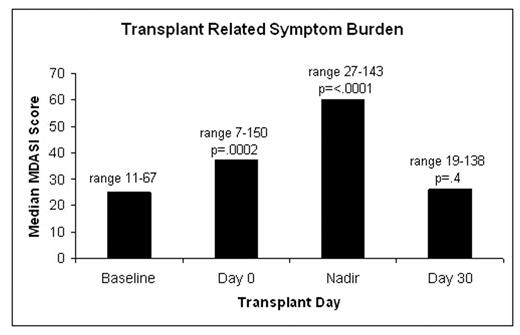Abstract
Background: Multiple myeloma (MM) is the most common indication for autografting in the United States. Although safe, autografting can be associated with substantial morbidity due to the toxic side effects of chemotherapy. Strategies aimed at minimizing symptoms post autografting may result in better tolerance. The risk factors for symptom development post autografting for MM have not been well characterized.
Purpose: To define pretransplant conditions which may be predictive of post-transplant symptom burden.
Methods: We performed prospective evaluation of symptom burden among 64 myeloma patients undergoing autograft at MDACC as well as retrospective review of pretransplant variables including patient demographics, performance status, albumin, disease status, and Charlson Comorbidity Index (CCI). Univariate analysis was performed to correlate pretransplant variables with posttransplant symptom burden as defined by M.D. Anderson Symptom Inventory (MDASI) scores at different timepoints post transplant.
Results: 64 patients were studied from 6/2000 to 5/2003. Patient characteristics are summarized in Table 1. Symptom burden increased from baseline to day 0 to nadir, with most patients returning to their baseline by day 30 post transplant (Figure 1). Table 2 summarizes the potential impact of pre-transplant variables on median MDASI scores at nadir. Patients with the highest MDASI scores at baseline had the highest MDASI scores at nadir in quartile analysis(p=.001). Patients with Charlson score of ≥ 3, age > 60, β 2M > 3, albumin ≤ 4, and female gender had a trend towards higher nadir MDASI scores. Other pre-transplant variables, including Durie-Salmon stage, LDH, hemoglobin, disease status at time of autograft, and time from diagnosis to autograft had no apparent correllation with symptom burden throughout transplant (data not shown).
Conclusions: Autografting for MM is associated with significant but reversible symptom burden during the first 30 days of the procedure. Baseline symptom burden is the most important predictor of post transplant symptom burden. Other potential predictors include Charlson score, age, β 2M, albumin, and female gender. The MDASI scoring system is a potentially useful means of following symptom burden post autografting that could be used to assess interventions aimed at reducing transplant related morbidity in MM patients.
Patient Characteristics
| . | Median (range) . |
|---|---|
| Age at transplantation, years | 55.2 (30–74) |
| Time to SCT, months | 7.5 (2.5–73.3) |
| Albumin at transplantation | 3.74 (2.9–4.5) |
| β2M at transplantation | 3.79 (1.4–19.3) |
| Charlson score at transplantation | 3.48 (2–6) |
| Disease status at transplantation | n (%) |
| First remission | 42 (65.6) |
| Primary refractory | 14 (21.9) |
| Other | 8 (13.6) |
| Preparative regimen | n (%) |
| Melphalan | 53 (82.8) |
| Other | 11 (17.2) |
| Male to female ratio | 1.5 : 1 |
| . | Median (range) . |
|---|---|
| Age at transplantation, years | 55.2 (30–74) |
| Time to SCT, months | 7.5 (2.5–73.3) |
| Albumin at transplantation | 3.74 (2.9–4.5) |
| β2M at transplantation | 3.79 (1.4–19.3) |
| Charlson score at transplantation | 3.48 (2–6) |
| Disease status at transplantation | n (%) |
| First remission | 42 (65.6) |
| Primary refractory | 14 (21.9) |
| Other | 8 (13.6) |
| Preparative regimen | n (%) |
| Melphalan | 53 (82.8) |
| Other | 11 (17.2) |
| Male to female ratio | 1.5 : 1 |
Impact of Pre-transplant Variables on Nadir MDASI Scores
| . | n . | Median . | (range) . |
|---|---|---|---|
| Charlson score | |||
| < 3 | 50 | 22 (1–97) | |
| ≥ 3 | 14 | 41 (3–72) | .09 |
| Age | |||
| ≤ 60 years | 43 | 23 (1–97) | |
| > 60 years | 21 | 31 (3–72) | .2 |
| β 2M | |||
| ≤3.0 | 34 | 20 (1–85) | |
| > 3.0 | 27 | 28 (4–97) | .2 |
| Albumin | |||
| ≤ 4.0 | 50 | 27 (1–97) | |
| > 4.0 | 14 | 19 (1–16) | .2 |
| Gender | |||
| Female | 26 | 30 (5–85) | |
| Male | 38 | 23 (1–97) | .2 |
| . | n . | Median . | (range) . |
|---|---|---|---|
| Charlson score | |||
| < 3 | 50 | 22 (1–97) | |
| ≥ 3 | 14 | 41 (3–72) | .09 |
| Age | |||
| ≤ 60 years | 43 | 23 (1–97) | |
| > 60 years | 21 | 31 (3–72) | .2 |
| β 2M | |||
| ≤3.0 | 34 | 20 (1–85) | |
| > 3.0 | 27 | 28 (4–97) | .2 |
| Albumin | |||
| ≤ 4.0 | 50 | 27 (1–97) | |
| > 4.0 | 14 | 19 (1–16) | .2 |
| Gender | |||
| Female | 26 | 30 (5–85) | |
| Male | 38 | 23 (1–97) | .2 |
Author notes
Corresponding author


This feature is available to Subscribers Only
Sign In or Create an Account Close Modal